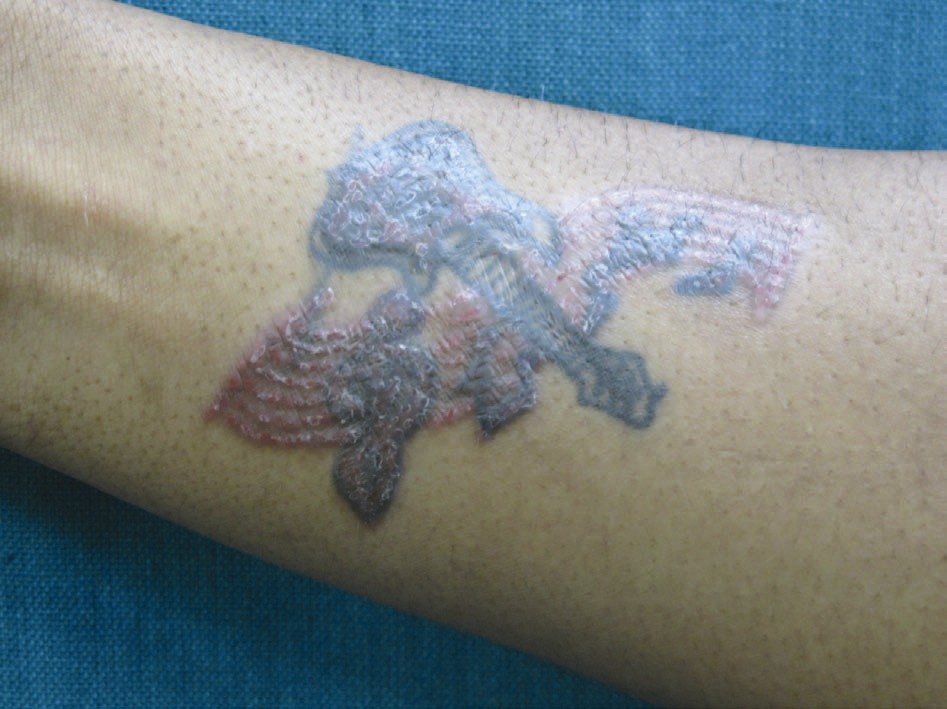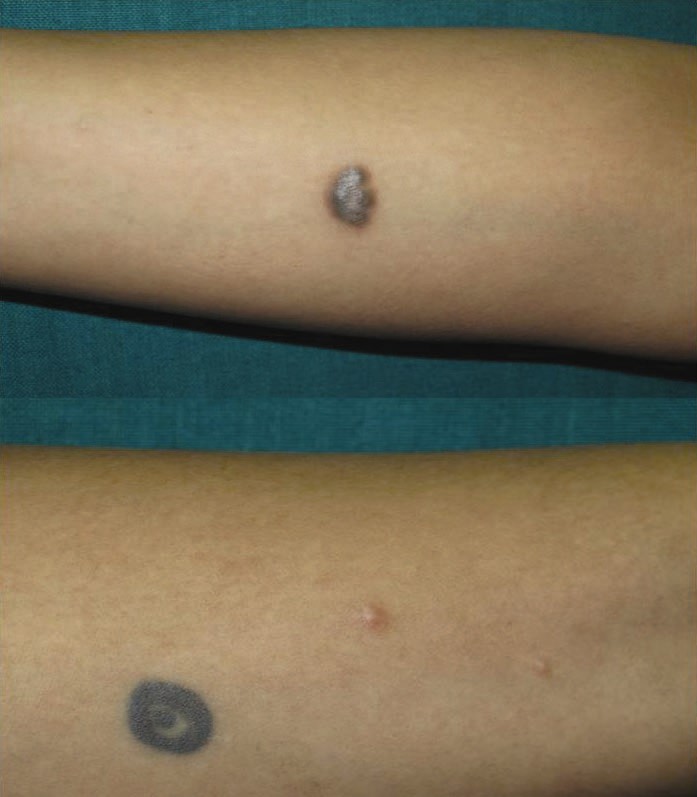Translate this page into:
Tattoo reactions-An epidemic on the surge: A report of 3 cases
Correspondence Address:
Swapnil A Sanghavi
Department of Skin and Venereal Diseases, Seth Gordhandas Sunderdas Medical College and King Edward Memorial Hospital, Parel-400 012, Mumbai, Maharashtra
India
| How to cite this article: Sanghavi SA, Dongre AM, Khopkar US. Tattoo reactions-An epidemic on the surge: A report of 3 cases. Indian J Dermatol Venereol Leprol 2013;79:231-234 |
Abstract
Tattooing has been practiced in India since ancient era. It has tremendous religious and spiritual significance. In addition, tattooing for cosmetic purposes has become quite popular in recent times. With this increasing trend, there is also an increased risk of adverse effects. Here, we have described two cases of lichenoid reaction developing to red ink in double- colored tattoos and a case of sarcoidal reaction to green tattoo.Introduction
Tattooing has been practiced in India since ancient era. It has tremendous religious and spiritual significance. In addition, tattooing for cosmetic purposes has become quite popular in recent times. With this increasing trend, there is also an increased risk of adverse effects. Cutaneous reactions to tattoos are uncommonly reported in literature. They are generally attributed to the metallic salts used in the preparation of the pigment. Allergic reactions to a particular pigment can manifest in several ways including allergic contact dermatitis and photoallergic dermatitis. Here, we have described two cases of lichenoid reaction developing to red ink in double-colored tattoos and a case of sarcoidal reaction to green tattoo.
Case Reports
Case 1
A 23-year-old male presented with complaints of itchy red raised lesions over a tattoo on his left arm. The tattoo was injected 3 weeks back. The patient had no history of any tattoos injected in the past. On examination, shiny erythematous nodules and plaques with superficial scaling were seen over areas where the red ink was originally present. The red ink was completely masked by the lesions, while the green ink was uninvolved [Figure - 1].
 |
| Figure 1: Indurated nodules over the red component of the tattoo. Green ink is spared |
Case 2
A 30-year-old male complained of itching, followed by appearance of red raised lesions over the tattoo on his right forearm. The tattoo was injected at a local parlor 4 weeks back. On examination, shiny erythematous papules and plaques along with scaling were seen over the site of red ink, which was completely masked. The green ink in the tattoo was not affected [Figure - 2].
 |
| Figure 2: Scaly erythematous plaques over the red ink with sparing of the green component |
Biopsies were taken from scaly erythematous plaques in both patients. It showed parakeratosis and moderate acanthosis with mild spongiosis of the epidermis. The dermoepidermal junction showed vacuolar degeneration. The dermis showed a lichenoid infiltrate consisting of lymphocytes and histocytes [Figure - 3] and [Figure - 4], suggesting diagnosis of lichenoid reaction to tattoo pigment.
 |
| Figure 3: Histopathology of Case 1 showing vacuolar degeneration with lichenoid infiltrate consisting of lymphocytes and histocytes. (H and E, ×40, inset ×400) |
 |
| Figure 4: Histopathology of Case 2 showing lichenoid infiltrate at the dermoepidermal junction consisting of lymphocytes and histiocytes (H and E, ×40, inset ×400) |
Both the patients were prescribed topical fluticasone cream 0.05% for local application in addition to oral anti-histamines. Q switched Nd YAG laser could not be tried due to its non availability.
Case 3
A 25-year-old female presented with a complaint of raised lesion over her left forearm since past 1 week. The lesion appeared over the site of a tattoo that was injected 2 years back. She also developed multiple red raised asymptomatic lesions over right upper and lower extremities. She had no history of cough, breathlessness, or redness of eyes. On examination, an indurated painless nodule was seen over a green tattoo on her left forearm [Figure - 5]. Also, multiple erythematous indurated nodules were present over right upper and lower limbs. Interestingly, another tattoo over the right forearm was unaffected [Figure - 5].
 |
| Figure 5: Indurated plaque over green tattoo on the forearm, while tattoo over the other forearm is spared. Erythematous nodules over non tattooed skin can also be seen |
Biopsy from the lesion on the tattoo showed the presence of non-caseating epithelioid granulomas surrounded by a sparse lymphocytic infiltrate in the dermis. The tattoo pigment was seen in the dermis [Figure - 6]. On further investigations, her chest X-ray showed perihilar and paratracheal lymphadenopathy. The serum ACE levels were raised, suggesting diagnosis of systemic sarcoidosis.
 |
| Figure 6: Histopathology showing the presence of non caseating epithelioid granulomas surrounded by a sparse lymphocytic infiltrate in the dermis. Tattoo pigment can also be visualized (H and E, ×40, inset ×400) |
The patient was referred to chest medicine department for further management and was lost to follow-up.
Discussion
Tattoo colors consist of inorganic pigments, organic dyes, or a combination of both. In the past, it appears that heavy metals, that were the backbone of tattooing for decades, have been replaced by organic colorants. [1]
Tattoo artists use various pigment compounds to create different colors and hues. Depending upon the compounds used and the color of the tattoo, a variety of cutaneous reactions can be expected. The composition of ink used for professional and amateur tattoo differs significantly. For amateur tattoos, carbon particles are used, while for professional tattoos, a mixture of insoluble metals with organic dyes is used.
Cutaneous reactions to tattoo are not uncommon. Several histological reactions to tattoo ink have been described including pseudolymphomatous, lichenoid, granulomatous, scleroderma or morphea-like, sarcoidal, pseudoepitheliomatous hyperplasia, allergic contact dermatitis and photoallergy. [2] Lichenoid and sarcoidal reactions are both less common than eczematous reactions. Recently, a perforating granulomatous reaction to tattoo pigment was described. [3]
Pathogenic mechanisms implicated in reactions to tattoo pigments include a localized, T-cell mediated, delayed hypersensitivity response (lichenoid and sarcoidal reaction). In addition, allergic reactions have been observed in the form of type I and III reactions, according to Coombs and Gell classification. [4]
Cutaneous hypersensitivity reactions, although most common with red (mercuric sulphide) tattoos, have also been reported with other colors like yellow (cadmium sulphide), brown (iron oxide), blue (cobalt), purple (manganese), green (chromium), and black (carbon) tattoos. [1]
Allergic reactions are more frequently seen to red tattoos than other colors. This is reflected in a literature review of 17 case reports by Aberer et al.,[4] which showed that red ink was responsible for 11 out of 26 reactions reported. These reactions may occur within days of the tattoo application or up to 17 years later.
Lichenoid reactions are more frequently reported with red pigment tattooing that contains mercury. Clinically, verrucous papules or plaques characteristic of hyperkeratotic lichen planus are usually seen. [5] However, both our patients presented with erythematous and indurated plaques with mild scaling, but showed the characteristic lichenoid pattern on biopsy, which is rare.
Sarcoidosis has been suggested to be a state of granulomatous hypersensitivity, with reactions to different antigens in a variety of organs. In 1955, Obermayer and Hassen [6] reported the first case of a sarcoidal reaction within a tattoo attributed to be a manifestation of systemic sarcoidosis. Since then, multiple cases have been described, most occurring in association with hilar adenopathy and pulmonary sarcoidosis. In 14 of 19 cases, tattoo reactions subsequently led to the diagnosis of systemic sarcoidosis, as in our patient. [7] Sarcoidal reaction to tattoo pigment is commonly described. It is a hypersensitivity reaction (type 4) that is localized to the tattooed area without the systemic manifestations of sarcoidosis.
Diagnosis of lichenoid or sarcoidal reaction is based on clinical and histopathological correlation. Patch testing done to detect such reactions are often negative in comparison to eczematous reactions that are usually patch test positive. [1] As various compounds are used to form different colors and hues, e.g., cadmium sulfide, titanium, aluminum, silicon, and calcium, identifying the individual component responsible for a tattoo reaction can be complicated. X-ray microanalysis of red pigment in patients with cutaneous reaction to red tattoo has demonstrated variety of other metals like aluminium, iron, calcium, titanium, silicon, and cadmium which though rare, may cause reactions. [8]
Currently data is lacking regarding the safety of tattoo pigment ingredients. Also, none of the tattoo ink or additives are FDA approved. As mercury present in red tattoos is known as a common cause for cutaneous reactions, mercury-free dyes such as cadmium red (cadmium selenide), senna, red ochre (ferric hydrate), and organic vegetable dyes like sandalwood or brazilwood are being used.
Steroids, laser therapy, and excision are the backbone of treatment for allergic reactions to tattoos.
Reactions to tattoos are increasingly being encountered in clinical dermatological practice. It is important for dermatologists to be aware of these reactions as their occurrence is bound to rise in future with increasing popularity of tattooing as a body art.
| 1. |
Kaur RR, Kirby W, Maibach H. Cutaneous allergic reactions to tattoo ink. J Cosmet Dermatol 2009;8:295-300.
[Google Scholar]
|
| 2. |
Ortiz AE, Alster TS. Rising concern over cosmetic tattoos. Dermatol Surg 2012;38:424-9.
[Google Scholar]
|
| 3. |
Sweeney SA, Hicks LD, Ranallo N, Iv NS, Soldano AC. Perforating granulomatous dermatitis reaction to exogenous tattoo pigment: A case report and review of the literature. Am J Dermatopathol 2011. [In press]
[Google Scholar]
|
| 4. |
Aberer W, Snauwaert JE, Render UM. Allergic reaction to pigments and metals. In: Christa De Cuyper, editor. Dermatologic complications with body art: Tattoos, piercings and permanent makeup, 1 st ed. Belgium: Springer link; 2010. p. 66-73.
[Google Scholar]
|
| 5. |
Winkelmann RK, Harris RB. Lichenoid delayed hypersensitivity reactions in tattoos. J Cutan Pathol 1979;6:59-65.
[Google Scholar]
|
| 6. |
Obermeyer ME, Hassen M. Sarcoidosis with sarcoidal reaction in tattoo. Arch Dermatol 1955;71:766.
[Google Scholar]
|
| 7. |
Antonovich DD, Callen JP. Development of sarcoidosis in cosmetic tattoos. Arch Dermatol 2005;141:869-72.
[Google Scholar]
|
| 8. |
Sowden JM, Cartwright PH, Smith AG, Hiley C, Slater DN. Sarcoidosis presenting with a granulomatous reaction confined to red tattoo. Clin Exp Dermatol 1992;17:446-8.
[Google Scholar]
|
Fulltext Views
6,650
PDF downloads
1,043





